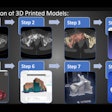
Abbreviated breast MRI is well-tolerated by patients and is the preferred imaging modality for screening for the majority of women, Australian researchers have reported.
In a patient satisfaction survey among 200 asymptomatic patients at average to intermediate risk of breast cancer, there was an overall patient preference for abbreviated breast MRI (75%) compared with mammography screening (25%), among those who were able to decide.
Intravenous contrast administration was rated as an excellent/good experience in 68% of cases, Dr. Linda Borella, a radiologist at St. Vincent's Private Hospital in Sydney, reported in an e-poster presentation at the recent Royal Australian & New Zealand College of Radiology (RANZCR) annual scientific meeting.
Overall, abbreviated breast MRI had a high cancer detection rate in nine out of 200 cases (4.5%), with a recall rate of 9% and positive predictive value (PPV) greater than screening mammography of 44%. Cancer detection was not limited by breast density.
"The results of this study may be used to inform further research to assess the cost-effectiveness of abbreviated breast MRI for wider population-based screening and to support the incorporation of abbreviated breast MRI into Australian breast cancer screening guidelines," noted Borella, who conducted the research with her colleague Dr. K. Gladysz.
Study details
Behind lung cancer, breast cancer is the second leading cause of cancer-related death in Australian women, and it remains the leading cause of death in women ages 45 to 64, the authors explained. The limitations of mammography are now well-recognized, and MRI has been proven to offer substantially higher sensitivity and thus improves the diagnosis of breast cancer compared with mammography.
All exams were performed on a 3-tesla MRI scanner using dedicated breast coils with patients in the prone position; 7.5 ml of intravenous gadobutrol (1 mmol/ml) was administered during the exam.
The study population comprised 199 women and one man, who were between the ages of 18 and 85 (mean, 53 years; standard deviation, ± 12.5). Of these, 172 (86%) were classified as BIRADS 1 and 2, with the remaining 28 (14%) being BIRADS 3-5.
A total of 155 patients were recommended to return to routine screening, and 28 patients identified as BIRADS ≥ 3 were recommended for further investigations, although 45 patients subsequently underwent further investigation.
"The disparity in numbers for further investigation was attributed to patients seeking additional investigations through general practitioners or other specialist referrals post abbreviated breast MRI results. These investigations were not recommended in the MRI reports," Borella pointed out.
There was no significant difference between breast density groups with mild, moderate, and marked density percentages of 33.5%, 32%, and 34.5%, respectively. Background enhancement demonstrated greater variability with mild, moderate, and marked categories being 66.5%, 24%, and 9.5%, respectively.
Nine breast cancers were identified in eight patients from the 200 screening-abbreviated breast MRI exams performed, giving a cancer detection rate of 9/200 (4.5%) with a recall rate of 9% and PPV greater than screening mammography of 44%.
The 9 cancers yielded were all in the group of patients recommended for further investigations by the radiologists (28 patients), with no cancers yielded in the remaining 17 patients who underwent further investigations with their general practitioners/other specialist referrals.
The final diagnoses were obtained from the surgical reports and are shown below.
| Biopsy results | Number |
| Benign breast tissue | 1 |
| Benign fibrocystic changes | 2 |
| Fibroadenoma | 6 |
| Hamartoma | 1 |
| Ductal carcinoma in situ (DCIS) | 3 |
| Invasive carcinoma | 6 |
| Total | 18 |
In the cancer group, there were seven women and one man with a mean age of 60 years. A family history of breast cancer was indicated in three of the eight patients and no patients with a family history of ovarian cancer.
The authors noted that 63% of their patients preferred MRI for screening, while 21% preferred mammography. The remaining 16% said they were unable to compare the two techniques.
The Kuhl Verdict
This is a fairly small study involving a retrospective analysis, but it provides good corroborating evidence for the fact that the concept of abbreviated MRI works, Dr. Christiane Kuhl, director and professor in the department of diagnostic and interventional radiology at University Hospital RWTH Aachen in Germany, told AuntMinnieEurope.com.
"What is new here is that the authors asked women about their preference, and it is quite noteworthy that three-quarters of them preferred MRI," she said. "I guess women had not been told at the time of asking that MRI is so much more successful in finding cancer -- because with this information, maybe even more women would 'prefer' abbreviated MRI."
Kuhl is a longstanding supporter of abbreviated MRI, having written one of the first articles on the topic in the Journal of Clinical Oncology in 2014.



















